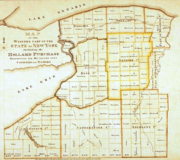The Holland Purchase
|
|
The Holland Land Company was formed in 1796 by Wilheim Willink and a group of fellow Dutch bankers to purchase from Robert Morris a large tract of land in what is now western New York State, an area later known as the Holland Purchase. It consisted of about 3,250,000 acres (13,000 km²) of land from a line approximately 12 miles (19 km) to the west of the Genesee River to the present western border and boundary of New York State. The bankers initially had hired trustees in the United States, because it was not legal at that time for them to directly own the property. Robert Morris, however, prevailed upon the New York Legislature to repeal that ordinance, which it did shortly thereafter. This area of western New York today is sometimes known as Genesee Country to distinguish it from the Finger Lakes region.
A sales office for the Holland Land Coupany was opened in 1801 by surveyor and agent Joseph Ellicott in Batavia where land was sold until 1846 when the company was dissolved. Some plots of land were given to persons upon condition that they establish improvements, such as inns and taverns, to encourage growth. The office still exists and is a museum of the Holland Purchase, designated a National Historic Landmark.
In 1802, the entire Holland Purchase, as well as the 500,000 acre (2,000 km²) Morris Reserve immediately to the east, was split off from Ontario County and constituted Genesee County. In the 40 years after it was erected, Genesee County was repeatedly split to form all or parts of the counties of Allegany (1806), Niagara (1808), Cattaraugus (1808), Chautaqua (1808), Erie (1821), Monroe (1821), Livingston (1821), Orleans (1824), and Wyoming (1841).
See also
- List of New York counties
- The Morris Reserve
- Phelps and Gorham Purchase
- Historic regions of the United States


